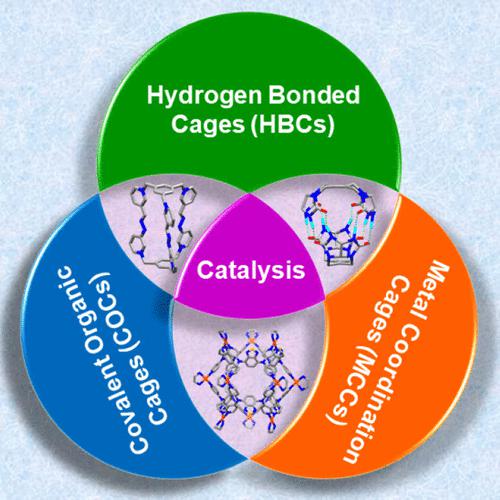当前位置:
X-MOL 学术
›
Chem. Rev.
›
论文详情
Our official English website, www.x-mol.net, welcomes your
feedback! (Note: you will need to create a separate account there.)
Molecular Cavity for Catalysis and Formation of Metal Nanoparticles for Use in Catalysis
Chemical Reviews ( IF 51.4 ) Pub Date : 2022-04-19 , DOI: 10.1021/acs.chemrev.1c00811 Rupak Saha 1 , Bijnaneswar Mondal 2 , Partha Sarathi Mukherjee 1
Chemical Reviews ( IF 51.4 ) Pub Date : 2022-04-19 , DOI: 10.1021/acs.chemrev.1c00811 Rupak Saha 1 , Bijnaneswar Mondal 2 , Partha Sarathi Mukherjee 1
Affiliation

|
The employment of weak intermolecular interactions in supramolecular chemistry offers an alternative approach to project artificial chemical environments like the active sites of enzymes. Discrete molecular architectures with defined shapes and geometries have become a revolutionary field of research in recent years because of their intrinsic porosity and ease of synthesis using dynamic non-covalent/covalent interactions. Several porous molecular cages have been constructed from simple building blocks by self-assembly, which undergoes many self-correction processes to form the final architecture. These supramolecular systems have been developed to demonstrate numerous applications, such as guest stabilization, drug delivery, catalysis, smart materials, and many other related fields. In this respect, catalysis in confined nanospaces using such supramolecular cages has seen significant growth over the years. These porous discrete cages contain suitable apertures for easy intake of substrates and smooth release of products to exhibit exceptional catalytic efficacy. This review highlights recent advancements in catalytic activity influenced by the nanocavities of hydrogen-bonded cages, metal–ligand coordination cages, and dynamic or reversible covalently bonded organic cages in different solvent media. Synthetic strategies for these three types of supramolecular systems are discussed briefly and follow similar and simplistic approaches manifested by simple starting materials and benign conditions. These examples demonstrate the progress of various functionalized molecular cages for specific chemical transformations in aqueous and nonaqueous media. Finally, we discuss the enduring challenges related to porous cage compounds that need to be overcome for further developments in this field of work.
中文翻译:

用于催化的分子腔和用于催化的金属纳米颗粒的形成
在超分子化学中使用弱分子间相互作用提供了一种替代方法来预测人工化学环境,如酶的活性位点。近年来,具有确定形状和几何形状的离散分子结构因其固有的孔隙率和易于使用动态非共价/共价相互作用进行合成而成为一个革命性的研究领域。几个多孔分子笼已经由简单的构建块通过自组装构建而成,它们经历了许多自我校正过程以形成最终的结构。这些超分子系统已被开发用于展示许多应用,例如客体稳定、药物输送、催化、智能材料和许多其他相关领域。在这方面,多年来,使用这种超分子笼在受限纳米空间中的催化已经有了显着的增长。这些多孔离散笼包含合适的孔,便于吸收底物和顺利释放产品,从而表现出卓越的催化功效。本综述重点介绍了在不同溶剂介质中受氢键笼、金属-配体配位笼和动态或可逆共价键有机笼的纳米腔影响的催化活性的最新进展。简要讨论了这三种超分子系统的合成策略,并遵循相似且简单的方法,这些方法表现为简单的起始材料和良性条件。这些例子展示了各种功能化分子笼在水性和非水性介质中特定化学转化的进展。最后,我们讨论了与多孔笼化合物相关的持久挑战,这些挑战需要克服,才能在这一工作领域取得进一步发展。
更新日期:2022-04-19
中文翻译:

用于催化的分子腔和用于催化的金属纳米颗粒的形成
在超分子化学中使用弱分子间相互作用提供了一种替代方法来预测人工化学环境,如酶的活性位点。近年来,具有确定形状和几何形状的离散分子结构因其固有的孔隙率和易于使用动态非共价/共价相互作用进行合成而成为一个革命性的研究领域。几个多孔分子笼已经由简单的构建块通过自组装构建而成,它们经历了许多自我校正过程以形成最终的结构。这些超分子系统已被开发用于展示许多应用,例如客体稳定、药物输送、催化、智能材料和许多其他相关领域。在这方面,多年来,使用这种超分子笼在受限纳米空间中的催化已经有了显着的增长。这些多孔离散笼包含合适的孔,便于吸收底物和顺利释放产品,从而表现出卓越的催化功效。本综述重点介绍了在不同溶剂介质中受氢键笼、金属-配体配位笼和动态或可逆共价键有机笼的纳米腔影响的催化活性的最新进展。简要讨论了这三种超分子系统的合成策略,并遵循相似且简单的方法,这些方法表现为简单的起始材料和良性条件。这些例子展示了各种功能化分子笼在水性和非水性介质中特定化学转化的进展。最后,我们讨论了与多孔笼化合物相关的持久挑战,这些挑战需要克服,才能在这一工作领域取得进一步发展。











































 京公网安备 11010802027423号
京公网安备 11010802027423号